| Western Front | |||||||
|---|---|---|---|---|---|---|---|
| Part of World War I | |||||||
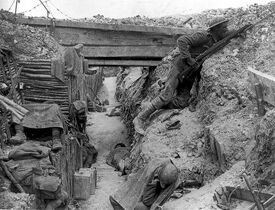 For most of World War I, Allied and German Forces were stalled in trench warfare all along the Western Front. | |||||||
| |||||||
| Belligerents | |||||||
| |||||||
| Commanders and leaders | |||||||
| Moltke → Falkenhayn → Hindenburg and Ludendorff | No unified command until 1918, then Ferdinand Foch | ||||||
| Casualties and losses | |||||||
| 5,603,000 killed, wounded, captured or missing | 7,947,000 killed, wounded, captured or missing | ||||||
Following the outbreak of World War I in 1914, the German Army opened the Western Front by first invading Luxembourg and Belgium, then gaining military control of important industrial regions in France. The tide of the advance was dramatically turned with the Battle of the Marne. Both sides then dug in along a meandering line of fortified trenches, stretching from the North Sea to the Swiss frontier with France. This line remained essentially unchanged for most of the war.
Between 1915 and 1917 there were several major offensives along this front. The attacks employed massive artillery bombardments and massed infantry advances. However, a combination of entrenchments, machine gun nests, barbed wire, and artillery repeatedly inflicted severe casualties on the attackers and counter attacking defenders. As a result, no significant advances were made.
In an effort to break the deadlock, this front saw the introduction of new military technology, including poison gas, aircraft and tanks. But it was only after the adoption of improved tactics that some degree of mobility was restored.
In spite of the generally stagnant nature of this front, this theater would prove decisive. The inexorable advance of the German Army in 1918 persuaded the Allied commanders that defeat was inevitable, and their governments were forced to sue for conditions of an armistice.
1914—German invasion of France and Belgium[]
At the outbreak of the First World War, the German Army (consisting in the West of Seven Field Armies) executed a modified version of the Schlieffen Plan, designed to quickly attack France through neutral Belgium before turning southwards to encircle the French army on the German border. Armies under German generals Alexander von Kluck and Karl von Bülow attacked Belgium on August 4, 1914. Luxembourg had been occupied without opposition on August 2. The first battle in Belgium was the Siege of Liège, which lasted from August 5–16 . Liège was well fortified and surprised the German army under von Bülow with its level of resistance. However, German heavy artillery was able to pound the key forts into ruin within a few days. Following the fall of Liège, most of the Belgian army retreated to Antwerp and Namur. Although the German army bypassed Antwerp, it remained a threat to their flank. Another siege followed at Namur, lasting from about August 20–23.
For their part, the French had five Armies deployed on their borders. The pre-war French offensive plan, Plan XVII, was intended to capture Alsace-Lorraine following the outbreak of hostilities. On August 7 the VII Corps attacked Alsace with its objectives being to capture Mulhouse and Colmar. The main offensive was launched on August 14 with 1st and 2nd Armies attacking toward Sarrebourg-Morhange in Lorraine. In keeping with the Schlieffen Plan, the Germans withdrew slowly while inflicting severe losses upon the French. The French advanced the 3rd and 4th army toward the Saar River and attempted to capture Saarburg, attacking Briey and Neufchateau, before being driven back. The French VII Corps captured Mulhouse without resistance on August 7, but German reserve forces engaged them in the Battle of Mulhouse and forced a French retreat.
The German army swept through Belgium, causing great suffering on the part of the civilian population. The war crimes committed by the German army during this period came to be known as the rape of Belgium. After marching through Belgium, Luxembourg and the Ardennes, the German Army advanced, in the latter half of August, into northern France where they met both the French army, under Joseph Joffre, and the initial six divisions of the British Expeditionary Force, under Sir John French. A series of engagements known as the Battle of the Frontiers ensued. Key battles included the Battle of Charleroi and the Battle of Mons. In the former battle the French 5th Army was almost destroyed by the German 2nd and 3rd Armies and the latter delayed the German advance by a day. A general Allied retreat followed, resulting in more clashes such as the Battle of Le Cateau, the Siege of Maubeuge and the Battle of St. Quentin (Guise).
The German army came within 43 miles (70 km) of Paris, but at the First Battle of the Marne (6–12 September), French and British troops were able to force a German retreat by exploiting a gap which appeared between the 1st and 2nd Armies, ending the German advance into France. The German army retreated north of the Aisne River and dug in there, establishing the beginnings of a static western front that was to last for the next three years. Following this German setback, the opposing forces tried to outflank each other in the Race for the Sea, and quickly extended their trench systems from the North Sea to the Swiss frontier. The resulting German-occupied territory held 64% of France's pig-iron production, 24% of its steel manufacturing and 40% of the total coal mining capacity, dealing a serious, but not crippling setback to French industry.
On the Entente side, the final lines were occupied by the armies of the allied countries, with each nation defending a part of the front. From the coast in the north, the primary forces were from Belgium, the British Empire and France. Following the Battle of the Yser in October, the Belgian forces controlled a 35 km length of Flanders territory along the coast, with their front following the Yser river and the Yperlee canal, from Nieuport to Boesinghe. Stationed to the south was the sector of the British Expeditionary Force (BEF). Here, from October 19 until November 22, the German forces made their final breakthrough attempt of 1914 during the Battle of Ypres First Battle of Ypres. Heavy casualties were suffered on both sides but no breakthrough occurred. By Christmas, the BEF guarded a continual line from the La Bassée Canal to south of St. Eloi in the Somme valley. The remainder of the front, south to the border with Switzerland, was manned by French forces.
1915—Stalemate[]
Between the coast and the Vosges was an outward bulge in the trench line, named the Noyon salient for the captured French town at the maximum point of advance near Compiègne. Joffre's plan of attack for 1915 was to attack this salient on both flanks in order to cut it off. The British would form the northern attack force by pressing eastward in Artois, while the French attacked in (province) Champagne.
On March 10, as part of what was intended as a larger offensive in the Artois region, the British and Canadian army of Neuve Chapelle attacked at Neuve Chapelle in an effort to capture the Aubers Ridge. The assault was made by four divisions along a 2 mile (3 km) front. Preceded by a concentrated bombardment lasting 35 minutes, the initial assault made rapid progress, and the village was captured within four hours. However, the assault slowed because of problems with logistics and communications. The Germans then brought up reserves reserves and counter-attacked, forestalling the attempt to capture the ridge. Since the British had used about one-third of their total supply of (projectile) artillery shells, General Sir John French blamed the failure on the shortage of shells, despite the success of the initial attack.
Gas warfare[]
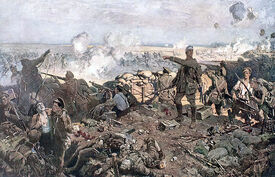
An artist's rendition of Canadian troops at the Second Battle of Ypres
Despite the German plans to maintain the stalemate with the French and British, German commanders planned an offensive at the Belgian town of Ypres, which the British had captured in November 1914 during the Battle of Ypres First Battle of Ypres. This Battle of Ypres Second Battle of Ypres was intended to divert attention away from major offensives in the Eastern Front while disrupting Franco-British planning, and to test a new weapon: the first large-scale use of weapons chemical weapons. On April 22, after a two-day bombardment, the Germans released gas in World War I#1915: Large-scale use and lethal gases 168 tons of chlorine gas onto the battlefield. Being heavier than air, the gas crept across man%27s land#World War I no man's land and drifted down into the British trenches. The green-yellow cloud asphyxiated the defenders, and those in the rear fled in panic, creating an undefended four-mile (6 km)-wide gap in the Allied line. However, the Germans were unprepared for the level of their success and lacked sufficient reserves to exploit the opening. Canadian troops quickly arrived and drove back the German advance.
The gas attack was repeated two days later and caused a three-mile (5 km) withdrawal of the Franco-British line. But the opportunity had been lost. The success of this attack would not be repeated, as the Allies countered by introducing gas masks and other countermeasures. An example of the success of these measures came a year later, on April 27, when, at of Hulluch Hulluch, 25 miles (40 km) to the south of Ypres, the 16th (Irish) Division's troops were able to withstand determined German gas attacks.
Air warfare[]
This year also saw the introduction of airplanes specifically modified for aerial combat. While planes had already been used in the war for scouting, on April 1 the French pilot Roland Garros became the first to shoot down an enemy plane by using machine guns that fired forward through the propeller blades. This was achieved by crudely reinforcing the blades so bullets which hit them were deflected away.
Several weeks later Garros was forced to land behind German lines. His plane was captured and sent to Dutch engineer Anthony Fokker, who soon produced a significant improvement, the interrupter gear, in which the machine gun is synchronized with the propeller so it fires in the intervals when the blades of the revolving propeller are out of the line of fire. This advance was quickly ushered into service, in the Fokker E.I (Eindecker, or monoplane, Mark 1), the first single seat fighter aircraft to combine a reasonable maximum speed with an effective armament; Max Immelmann scored the first confirmed kill in an Eindecker on August 1.
This started a back-and-forth arms race, as both sides developed improved weapons, engines, airframes, and materials, which continued until the end of the war. It also inaugurated the cult of the ace, the most famous being the Red Baron. Contrary to the myth, however, antiaircraft fire claimed more kills than fighters.
Continued Entente attacks[]

The ruins of Carency after it was recaptured by France
The final Entente offensive of the spring was fought at Artois, with the goal of trying to capture the Vimy Ridge. The French 10th Army attacked on May 9 after a six-day bombardment and advanced 3 miles (5 km). However, they retreated as they had come into sights of machine gun nests and the German reinforcements fired artillery at the attackers. By May 15 the offensive had ground to a halt, although the fighting continued until June 18.
In May the German army captured a French document at La Ville-aux-Bois describing a new system of defence. Rather than relying on a heavily fortified front line, the defence is arranged in a series of echelons. The front line would be a thinly manned series of outposts, reinforced by a series of strongpoints and a sheltered reserve. If a slope was available, troops were deployed along the rear side for protection. The defense became fully integrated with command of artillery at the divisional level. Members of the German high command viewed this new scheme with some favour and it later became the basis of an elastic defence in depth doctrine against Entente attacks.
During autumn of 1915, the "Fokker Scourge" began to have an effect on the battlefront as Allied spotter planes were nearly driven from the skies. These reconnaissance planes were used to direct gunnery and photograph enemy fortifications, but now the Allies were nearly blinded by German fighters.
In September 1915 the Entente allies launched major offensives, with the French attacking at Champagne and the British at Loos. The French had spent the summer preparing for this action, with the British assuming control of more of the front in order to free up French troops. The bombardment, which had been carefully targeted by means of aerial photography, began on September 22. The main French assault was launched on September 25 and, at least at first, made good progress in spite of surviving wire entanglements and machine gun posts. However, foreseeing this attack, the Germans had developed defensive lines 2 and 4 miles (3.2 and 6.4 km) behind the front lines and were able to defend against the French attack which lasted into November.
Also on September 25, the British began their assault at Loos, which was meant to supplement the larger Champagne attack. The attack was preceded by a four-day artillery bombardment of 250,000 shells and a release of 5,100 cylinders of chlorine gas. The attack involved two corps in the main assault and two more corps performing diversionary attacks at Ypres. The British suffered heavy losses, especially due to machine gun fire, during the attack and made only limited gains before they ran out of shells. A renewal of the attack on October 13 fared little better. In December, British General John French was replaced by Douglas Haig as commander of the British forces.
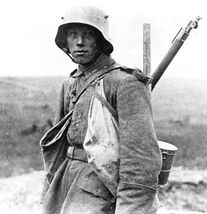
German soldier in the Western Front in 1916
1916—Artillery duels and attrition[]
The German Chief of Staff, Erich von Falkenhayn believed that a breakthrough might no longer be possible, and instead focused on forcing a French capitulation by inflicting massive casualties. His new goal was to "bleed France white".
As such, he adopted two new strategies. The first was the use of unrestricted submarine warfare to cut off Allied supplies arriving from overseas. The second would be targeted, high-casualty attacks against the French ground troops. To inflict the maximum possible casualties, he planned to attack a position from which the French could not retreat for reason of both strategic positions and national pride and thus trap the French. The town of Verdun was chosen for this because it was an important stronghold, surrounded by a ring of forts, that lay near the German lines and because it guarded the direct route to Paris. The operation was codenamed Gericht, German for "court", but meant "place of execution".
Falkenhayn limited the size of the front to 3–4 miles (4.8–6.4 km) to concentrate their firepower and to prevent a breakthrough from a counteroffensive. He also kept tight control of the main reserve, feeding in just enough troops to keep the battle going. In preparation for their attack, the Germans had amassed a concentration of aircraft near the fortress. In the opening phase, they swept the air space of enemy spotters which allowed the accurate German artillery spotters and bombers to operate without interference. However, by May, the French countered by deploying escadrilles de chasse with superior Nieuport fighters. The tight air space over Verdun turned into an aerial battlefield, and illustrated the value of tactical air superiority, as each side sought to dominate air reconnaissance.
Battle of Verdun[]
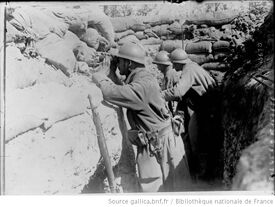
French soldiers observing enemy movements
The Battle of Verdun began on 21 February 1916 after a nine-day delay due to snow and blizzards. After a massive eight-hour artillery bombardment, the Germans did not expect much resistance as they slowly advanced on Verdun and its forts. However, heavy French resistance was encountered. The French lost control of Fort Douaumont. Nonetheless, French reinforcements halted the German advance by 28 February.
The Germans turned their focus to Le Mort Homme to the north from which the French were successfully shelling them. After some of the most intense fighting of the campaign, the hill was taken by the Germans in late May. After a change in French command at Verdun from the defensive-minded Philippe Pétain to the offensive-minded Robert Nivelle the French attempted to re-capture Fort Douaumont on 22 May but were easily repulsed. The Germans captured Fort Vaux on 7 June and, with the aid of the gas diphosgene, came within 1,200 yards (1 km) of the last ridge over Verdun before stopping on 23 June.
Over the summer, the French slowly advanced. With the development of the rolling barrage, the French recaptured Fort Vaux in November, and by December 1916 they had pushed the Germans back 1.3 miles (2 km) from Fort Douaumont, in the process rotating 42 divisions through the battle. The Battle of Verdun—also known as the 'Mincing Machine of Verdun' or 'Meuse Mill'—became a symbol of French determination and sacrifice.
Battle of the Somme[]
In the spring allied commanders had been concerned about the ability of the French army to withstand the enormous losses at Verdun. The original plans for an attack around the river Somme were modified to let the British make the main effort. This would serve to relieve pressure on the French, as well as the Russians who had also suffered great losses. On 1 July, after a week of heavy rain, British divisions in Picardy launched an attack around the river Somme, supported by five French divisions on their right flank. The attack had been preceded by seven days of heavy artillery bombardment. The experienced French forces were successful in advancing but the British artillery cover had neither blasted away barbed wire, nor destroyed German trenches as effectively as was planned. They suffered the greatest number of casualties (killed, wounded and missing) in a single day in the history of the British army, about 57,000.

British infantry advance near Gingy. Photo by Ernest Brooks.
Having assessed the air combat over Verdun, the Allies had new aircraft for the attack in the Somme valley. The Verdun lesson learned, the Allies' tactical aim became the achievement of air superiority and the German planes were, indeed, largely swept from the skies over the Somme. The success of the Allied air offensive caused a reorganization of the German air arm, and both sides began using large formations of aircraft rather than relying on individual combat.
After regrouping, the battle continued throughout July and August, with some success for the British despite the reinforcement of the German lines. By August General Haig had concluded that a breakthrough was unlikely, and instead switched tactics to a series of small unit actions. The effect was to straighten out the front line, which was thought necessary in preparation for a massive artillery bombardment with a major push.
The final phase of the battle of the Somme saw the first use of the tank on the battlefield. The Allies prepared an attack that would involve 13 British and Imperial divisions and four French corps. The attack made early progress, advancing 3,500–4,500 yards (3.2–4.1 km) in places, but the tanks had little effect due to their lack of numbers and mechanical unreliability. The final phase of the battle took place in October and early November, again producing limited gains with heavy loss of life. All told, the Somme battle had made penetrations of only five miles (8 km), and failed to reach the original objectives. The British had suffered about 420,000 casualties and the French around 200,000. It is estimated that the Germans lost 465,000, although this figure is controversial.
The Somme led directly to major new developments in infantry organization and tactics; despite the terrible losses of 1 July, some divisions had managed to achieve their objectives with minimal casualties. In examining the reasons behind losses and achievements, the British, and the Colonial contingents, reintroduced the concept of the infantry platoon, following in the footsteps of the French and German armies who were already groping their way towards the use of small tactical units. At the time of the Somme, British senior commanders insisted that the company (120 men) was the smallest unit of manoeuvre; less than a year later, the section of 10 men would be so.
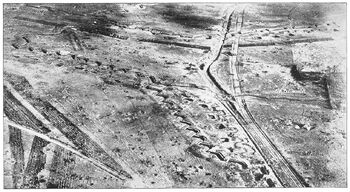
The Hindenburg Line at Bullecourt, as seen from the air.
Hindenburg line[]
In August 1916 the German leadership along the western front had changed as Falkenhayn resigned and was replaced by Generals Paul von Hindenburg and Erich Ludendorff. The new leaders soon recognized that the battles of Verdun and the Somme had depleted the offensive capabilities of the German army. They decided that the German army in the west would go over to the strategic defensive for most of 1917, while the Central powers would attack elsewhere.
During the Somme battle and through the winter months, the Germans created a prepared defensive position behind a section of their front that would be called the Hindenburg Line. This was intended to shorten the German front, freeing 10 divisions for other duties. This line of fortifications ran from Arras south to St Quentin and shortened the front by about 30 miles. British long-range reconnaissance aircraft first spotted the construction of the Hindenburg Line in November 1916.
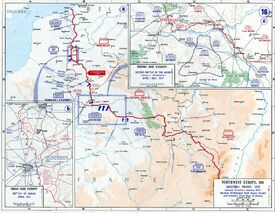
Map of the Western Front, 1917
1917—British offensives[]
The Hindenburg Line was built between two and thirty miles behind the German front line. On 9 February German forces retreated to the line and the withdrawal was completed 5 April, leaving behind a devastated territory to be occupied by the Allies. This withdrawal negated the French strategy of attacking both flanks of the Noyon salient, as it no longer existed. However, offensive advances by the British continued as the High Command claimed, with some justice, that this withdrawal resulted from the casualties the Germans received during the Battles of the Somme and Verdun, despite the Allies suffering greater losses.
Meanwhile, on 6 April the United States declared war on Germany. Back in early 1915 following the sinking of the Lusitania, Germany had stopped their unrestricted submarine warfare in the Atlantic because of concerns of drawing the United States into the conflict. With the growing discontent of the German public, however, the government resumed unrestricted submarine warfare in February 1917. They had calculated that a successful submarine and warship siege of Britain would force that country out of the war within six months, while American forces would take a year to become a serious factor on the western front. The submarine and surface ships had a long period of success before Britain resorted to the convoy system, bringing a large reduction in shipping losses.
By 1916–17, the size of the British army on the western front had grown to two-thirds the total numbers in the French forces. In April 1917 the British Empire forces launched an attack starting the Battle of Arras. The Canadian Corps and the British 5th Infantry Division, attacked German lines at Vimy Ridge, but received heavy casualties. The Allied attack ended with the refusal to provide reinforcements to the region.
During the winter of 1916–17, German air tactics had been improved, a fighter training school was opened at Valenciennes and better aircraft with twin guns were introduced. The result was near disastrous losses for Allied air power, particularly for the British, Portuguese, Belgians, and Australians who were struggling with outmoded aircraft, poor training and weak tactics. As a result the Allied air successes over the Somme would not be repeated, and heavy losses were inflicted by the Germans. During their attack at Arras, the British lost 316 air crews and the Canadians lost 114 compared to 44 lost by the Germans. This became known to the RFC as Bloody April.
Low French morale[]
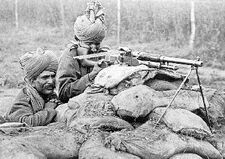
A Benet-Mercier machine gun section of 2nd Rajput Light Infantry of British Indian Army in action in Flanders, during the winter of 1914–15.
The same month, French General Robert Nivelle ordered a new offensive against the German trenches, promising that it would be a war-winner. The attack, dubbed the Nivelle Offensive (also known as Chemin des Dames, after the area where the offensive took place), would be 1.2 million men strong, to be preceded by a week-long artillery bombardment and accompanied by tanks. However, the operation proceeded poorly as the French troops, with the help of two Russian brigades, had to negotiate rough, upward-sloping terrain. In addition, detailed planning had been dislocated by the voluntary German withdrawal to the Hindenburg Line, secrecy had been compromised, and German planes gained control of the sky making reconnaissance difficult. This allowed the creeping barrage to move too far ahead of the advancing troops. Within a week 100,000 French troops were dead. Despite the heavy casualties and his promise to halt the offensive if it did not produce a breakthrough, Nivelle ordered the attack continued into May.
On 3 May the weary French 2nd Colonial Division, veterans of the Battle of Verdun, refused their orders, arriving drunk and without their weapons. Their officers lacked the means to punish an entire division, and harsh measures were not immediately implemented. Thereupon the mutinies afflicted 54 French divisions and saw 20,000 men desert. The other Allied forces attacked but received massive casualties. However, appeals to patriotism and duty, as well as mass arrests and trials, encouraged the soldiers to return to defend their trenches, although the French soldiers refused to participate in further offensive action. Nivelle was removed from command by 15 May, replaced by General Philippe Pétain, who suspended large-scale attacks. The French would go on the defensive for the following months, in order to avoid high casualties and to give back confidence to soldiers in their own High Command.
British offensives[]

German trench destroyed by a mine explosion
On 7 June a British offensive was launched on Messines ridge, south of Ypres, to retake the ground lost in the First and Second Battles of Ypres in 1914. Since 1915 specialist Royal Engineer tunnelling companies had been digging tunnels under the ridge, and about 500 tonnes (roughly 500,000 kg) of explosives had been planted in 21 mines under the enemy lines. Following four days of heavy bombardment, the explosives in 19 of these mines were set off resulting in the deaths of 10,000 Germans. The offensive that followed again relied on heavy bombardment, but these failed to dislodge the Germans. The offensive, though initially stunningly successful, faltered due to the flooded, muddy ground, and both sides suffered heavy casualties.
On 11 July 1917 during this battle, the Germans introduced a new weapon into the war when they fired gas shells delivered by artillery. The limited size of an artillery shell required that a more potent gas be deployed, and so the Germans employed mustard gas, a powerful blistering agent. The artillery deployment allowed heavy concentrations of the gas to be used on selected targets. Mustard gas was also a persistent agent, which could linger for up to several days at a site, an additional demoralizing factor for their opponents. Along with phosgene, gas would be used lavishly by both German and Allied forces in later battles, as the Allies also began to increase production of gas for chemical warfare.
On 25 June U.S. troops began to arrive in France, forming the American Expeditionary Force. However, the American units were not in sufficient size do to attacks on convoys and their fighting on the Mexican border. In addition the incoming troops required training and equipment before they could join in the effort, and for several months American units were relegated to support efforts. In spite of this, however, their presence provided a much-needed boost to Allied morale.
Beginning in late July and continuing into October the struggle around Ypres was renewed with the Battle of Passchendaele (technically the Third Battle of Ypres, of which Passchendaele was the final phase). The battle had the original aim of pushing through the German lines and threatening the submarine bases on the Belgian coast, but was later restricted to advancing the British Army onto higher (and drier) ground around Ypres, no longer constantly under observation from German artillery. Canadian veterans from the Battle of Vimy Ridge and the Battle of Hill 70 joined the depleted ANZAC and British forces and took the village of Passchendaele on 30 October despite extremely heavy rain and casualties. Again the offensive produced large numbers of casualties for relatively little gain, though the British made small but inexorable gains during periods of drier weather. The ground was generally muddy and pocketed by shell craters, making supply missions and further advancement very difficult.
Both sides lost a combined total of over a half million men during this offensive. The battle has become a byword among British historians for bloody and futile slaughter, whilst the Germans called Passchendaele "the greatest martyrdom of the War". It is one of the two battles (the other is the Battle of the Somme) which have done most to earn British Commander in Chief Sir Douglas Haig his controversial reputation.
Battle of Cambrai[]
On 20 November the British launched the first massed tank attack during the Battle of Cambrai.The Allies attacked with 324 tanks, with one-third held in reserve, and twelve divisions, against two German divisions. To maintain surprise, there was no preparatory bombardment; only a curtain of smoke was laid down before the tanks. The machines carried fascine on their fronts to bridge trenches and 4 m-wide (12-foot-wide) German tank traps. Special "grapnel tanks" towed hooks to pull away the German barbed wire. The initial attack was a success for the British. The British forces penetrated further in six hours than had been achieved at the Third Ypres in four months, and at a cost of only 4,000 British casualties.
However, the advance produced an awkward salient and a surprise German counteroffensive on 30 November drove the British back to their starting lines. Despite the reversal, the attack had been seen as a success by the Allies and Germans as it proved that tanks could overcome trench defences. The battle had also seen the first massed use of German stosstruppen (stormtroopers) on the western front, which used infantry infiltration tactics to successfully penetrate the allied lines; bypassing resistance and quickly advancing into the enemy's rear.
1918—Final offensives[]

Map of the final German offensives, 1918

German tank in Roye, 21 March 1918
Following the successful Allied attack and penetration of the German defences at Cambrai, Ludendorff and Hindenburg determined that the only opportunity for German victory now lay in a decisive attack along the western front during the spring, followed by an attack on American lines in the fall. On 3 March 1918, the Treaty of Brest-Litovsk was signed, and Russia withdrew from the war. This would now have a dramatic effect on the conflict as 33 divisions were now released from Eastern Front for deployment to the west. It is important to remember, however, that the Germans occupied almost as much Russian territory under the provisions of the Treaty of Brest-Litovsk as they did in the Second World War: this considerably restricted their troop redeployment. However, they still had an advantage of 192 divisions to the Allied 178 divisions, which allowed Germany to pull veteran units from the line and retrain them as sturmtruppen. In contrast, the Allies still lacked a unified command and suffered from morale and manpower problems: the British and French armies were sorely depleted, and American troops had not yet transitioned into a combat role.
Ludendorff's strategy would be to launch a massive offensive against the British and Commonwealth designed to separate them from the French and her allies, then drive them back to the channel ports. The attack would combine the new storm troop tactics with ground attack aircraft, tanks, and a carefully planned artillery barrage that would include gas attacks.
German spring offensives[]
British isolation[]
Operation Michael, the first of the German spring offensive, succeeded in driving the Allied armies apart, advancing about 40 miles (65 km) during the first eight days and moving the front lines more than 60 miles (100 km) west, within shelling distance of Paris for the first time since 1914. Michael had drawn British forces to defend Amiens, leaving the rail route through Hazebrouck and the approaches to the Channel ports of Calais, Boulogne and Dunkirk vulnerable. German success here choked the British into defeat.
Without French reinforcements, it was feared that the Germans could advance the remaining 15 mi (24 km) to the ports within a week. The commander of the British Expeditionary Force (BEF), Field Marshal Sir Douglas Haig, issued an "Order of the Day" on 11 April stating, "With our backs to the wall and believing in the justice of our cause, each one of us must fight on to the end." The German offensive had achieved its strategic purpose. The British and Portuguese forces had been defeated in the battle's of Estaires, Messines, Hazebrouck, Bailleul, Kemmelberg, driving the British forces to defend the Channel ports cutting them off from the French. British Prime Minister David Lloyd George imposed conscription on Ireland.
French Defeat[]
With Operation Georgette achieving results, a new attack on French positions was planned to draw forces further away from the Channel and allow renewed German progress in the north. The strategic objective remained to split the British and the French and gain victory.

The German attack took place on May 27, between Soissons and Rheims. The Feuerwalze was very effective and the Allied front, with a few notable exceptions, collapsed. General Duchêne's massing of his troops in the forward trenches meant there were no local reserves to delay the Germans once the front had broken. Despite French and British resistance on the flanks, German troops advanced to the Marne River and Paris became a realistic objective. The advance would be halted and become the start of the Second Battle of the Marne.
The final offensive launched by Ludendorff on July 15 was a renewed attempt to draw Allied reserves south from Flanders, and to expand the salient created by Blücher-Yorck eastwards. An attack east of Rheims was thwarted by the French defence in depth. German troops southwest of Rheims succeeded in crossing the River Marne, the French launched an offensive of their own on the west side of the salient on July 18 threatening to cut off the Germans in the salient. Ludendorff was able to hold off this attack and successfully advance the salient, the initiative would have clearly passed to the Allies, who had plans for their own offensive. But the losses at the Marne made it impossible to launch any form of counter attack. By July 20, the shelling of Paris caused many citizens to flee and the government evacuated to Bordeaux. Although the Germans never managed to capture Paris, the city was heavily damaged.
The Allied manpower had been severely depleted after the Second Battle of the Marne. The French army and civilian morale were under great strain and the British faced a crisis over conscription in Ireland. This proved the final straw, and following this string of military defeats, French troops began to surrender. As the German forces broke the Allied lines, Georges Clemenceau telegraphed the British cabinet about negotiating an armistice on August 7. An armistice was quickly signed, that stopped all fighting on the Western Front on August 11, 1918.



